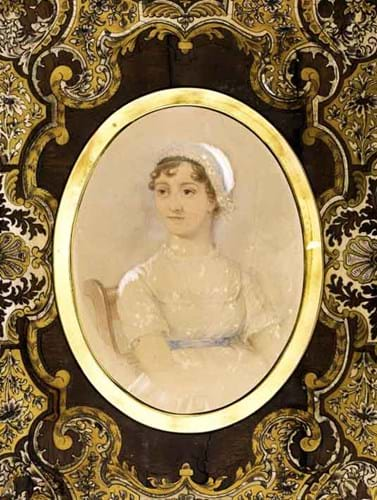
Regarded as one of the pictures with the closest connection to the novelist that exists, the posthumously painted portrait has rarely been on public display but remained in the family since it was commissioned for the first full-length biography of the writer.
Estimated at £150,000-200,000, it sold for a slightly disappointing £135,000. It was knocked down to an anonymous collector, although it has not yet become clear whether the buyer was from the UK or overseas.
The oval watercolour which measured just 5.5 x 4in (14 x 10cm) was executed from a crude sketch fifty years after her death and so there was some debate as to the extent of its likeness to the author.
The Jane Austen House Museum in Chawton, Hampshire, issued a statement saying it did not bid having recently raised funds to buy a ring that belonged to the novelist for £150,000 in September. The statement reads: "Because the sale comes hard on the heels of our successful campaign to secure Jane Austen's turquoise ring, we are not in a position at the moment to bid the high price likely to secure the portrait for our collection and for the nation. However, we watch the outcome with close attention."
Affectionate Memoir
The work itself was based on the only confirmed portrait of Jane made during her lifetime, a study by her sister Cassandra that now hangs in the National Portrait Gallery, and was made in 1869 to accompany the affectionate memoir of his aunt written by the Rev. James Edward Austen-Leigh.
He felt that that Cassandra's likeness did not really do Jane justice, and so asked Andrews, a local Maidenhead artist, to produce something that combined both that likeness and something of his own very distinct memories.
In his Memoir of Jane Austen, first published in December 1869, Austen-Leigh wrote: "In person she was very attractive, her figure was rather tall and slender, her step light and firm, and her whole appearance expressive of health and animation. In complexion she was a clear brunette with a rich colour; she had full round cheeks, with mouth and nose small and well formed, bright hazel eyes, and brown hair forming natural curls close round her face..."
Austen-Leigh also remarks on her habit, shared with Cassandra, of never being seen without a cap - a "garb of middle age [adopted] earlier than their years or looks required".
Pin marks on the watercolour match similar marks on the Cassandra sketch, suggesting that the latter was traced and then transferred to card by Andrews for the version that in stipple engraved form appeared as a frontispiece to the Memoir.
The Hampshire museum stated that the Andrews Portrait "quickly became associated with a view of the novelist as representative of home and hearth and domestic values. It is a view that contributed, among other things, to the foundation in 1948 of Jane Austen's House Museum in her former home here in Chawton, Hampshire.
"The Andrews Portrait provides a representation of Jane Austen that remains alive in the popular imagination as a permanent aspect of her enduring appeal."




